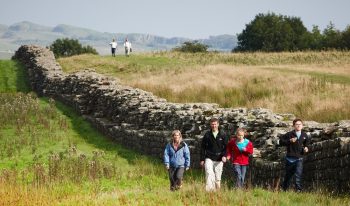By Denny Dyroff, Entertainment Editor, The Times
With the “shelter in place” order brought about because of the COVID-19 pandemic, you can no longer go outside into the world. But you can bring the world inside to you.
You can make virtual visits to cities, museums, amusement parts, cultural sites and a wide variety of other destinations.
Here are several suggestions of places to visit “virtually” – a smorgasbord of tasty treats to be enjoyed in the comfort of your home. This week, the primary focus is on the British Isles.
This is the time of year when many people make visits to the United Kingdom and, with the help of the internet, you can too.
One of the most cherished sites in London is Buckingham Palace. Fortunately, Queen Elizabeth’s home is fully accessible via a video tour on YouTube (https://www.youtube.com/watch?v=gen0NgJjry4).
The Tower of London is another popular site. The historical prison, which was founded in 1066, has been the final residence of many of England’s most famous figures, including Anne Boleyn and Catherine Howard, two of Henry VIII’s wives. Now, it’s quite a popular tourist attraction where you can go on a 360-degree tour of the castle and its grounds(https://www.youtube.com/watch?v=yeLQVare-3k).
St. Paul’s Cathedral is one of London’s most recognizable landmarks and hosts over two million visitors every year. You can visit via a virtual tour from 360 Cities (https://www.360cities.net/image/inside-st-paul-s-cathedral).
Stonehenge is a prehistoric World Heritage Site is estimated to have been built back as far as 3,000 BCE. Today, it’s a must-see for tourists and locals. Take a 360-degree tour of the famous landmark via video tour on YouTube (https://www.youtube.com/watch?v=_RyqU1r1Fmk).
In Bath, you can visit the legendary Roman Baths (https://www.romanbaths.co.uk/walkthrough. You’ll be able to take a look at Bath’s iconic “healing” waters from your home computer. Using the site’s official virtual tour on its website, you can discover the Sacred Spring, the Roman Temple, and the Roman Bath
House.
Another relic from the Roman Empire, Hadrian’s Wall is estimated to date back to 128 CE. It stretches 73 miles coast-to-coast across England. You can view the wall in what seems like real life thanks by visiting English Heritage’s 360-degree virtual tour (https://www.youtube.com/watch?v=kGcpiwL3CEg).
If you’re a fan of the literature written by Charlotte, Anne, and Emily Brontë, you’re in luck. Google Arts & Culture (https://artsandculture.google.com/story/FwLyGtC06USyJA) offers a virtual tour of the all places that inspired the Brontë Sisters.
And, if you’re a music fan, no trip to England would be complete without a visit to Abbey Road Studios in London – the legendary studio that is famous for being the recording studio used by the Beatles as well as many other British rock bands. You can enjoy a tour presented by Google (https://www.abbeyroad.com/news/google-presents-inside-abbey-road-1003?AspxAutoDetectCookieSupport=1).
York Minster in York (https://www.york360.co.uk/movies/york-minster-interior.htm ) is the largest cathedral of its kind in Northern Europe. The beautiful historic site is famous for its unusual stones and medieval stained glass.
Giants Causeway in Northern Ireland is another worthwhile tourist destination. The odd, interlocking stones have made the Giants Causeway a popular natural wonder. It gets its name from stories claiming Irish giant Finn McCool formed it when he was attempting to cross the Irish Sea. You can check it out at the National Trust website (https://www.nationaltrust.org.uk/giants-causeway/features/take-a-virtual-tour-of-the-giants-causeway?awc=3795_1587148311_51431446614873859d363fe54b35b29d&campid=Affiliates_Central_Mem_AWIN_Standard&aff=78888).
Loch Ness, a freshwater loch in the Scottish Highlands, is known for the legend of the mysterious Loch Ness Monster. You can visit Loch Ness for a virtual tour on Google Maps (https://www.google.com/maps/@57.1866913,-4.6170689,2a,90y,179.9h,82.17t/data=!3m6!1e1!3m4!1sFB8R6jT4YbOQd8Kpy4Xg7g!2e0!7i13312!8i6656).
Another popular attraction in Scotland is Edinburgh Castle. The historical fortress’ elevated position allows it to dominate the city’s skyline. Sitting on top of Castle Rock, it initially served as a royal castle and is an important monument in Scottish heritage. The 360-degree aerial tour (https://www.youtube.com/watch?v=Zu-KVWSqJlI) takes you around the castle and also provides an opportunity to see across the whole of the Scottish capital.
If you’re already across the Atlantic on your virtual vacation around the British Isles, you might as well hop across the English Channel for a visit to the Palace of Versailles.
Thanks to the partnership between the Palace of Versailles and Google Arts & Culture (https://artsandculture.google.com/project/versailles), you can now visit the Palace of Versailles using virtual reality. “VersaillesVR: the Palace is Yours” gives you the opportunity to freely explore the State Apartments, discover incredible new cultural and multimedia content, and enjoy an extraordinary range of works of art and furniture from every angle.
From Paris, you can head east to Austria to visit Schönbrunn Palace.
Schönbrunn Palace is one of Austria’s most visited sites. This World Heritage Site, located in Hietzing, Vienna, was the summer palace for many of the Hapsburg rulers. Not only can you get a good look at some of the most famous artworks in the palace, you can also take a walking tour via Street View (https://artsandculture.google.com/partner/schloss-schoenbrunn).
And, one more interesting stop to make before you leave Europe is located in the far north – The Faroe Islands.
The Faroe Islands is a popular tourist destination for those seeking something out of the ordinary. The Faroe Islands is a self-governing archipelago, part of the Kingdom of Denmark.
It comprises 18 rocky, volcanic islands between Iceland and Norway in the North Atlantic Ocean, connected by road tunnels, ferries, causeways and bridges. Hikers and birdwatchers are drawn to the islands’ mountains, valleys and grassy heathland, and steep coastal cliffs that harbor thousands of seabirds. With almost 20 major islands and just under 50,000 people, the sparse and beautiful destination is ready for wanderlusters with cabin fever to explore without leaving home.
Guðrið Højgaard, Director of Visit Faroe Islands (https://www.visitfaroeislands.com/), said in a statement: “We believe that our remote islands are the perfect place to inspire people in lockdown – and, naturally, we hope to welcome them in person once everyone is free to travel again.”
The Faroes are closed to tourists until the end of April at the earliest. The impact of COVID-19 has been limited, as the islands have the highest testing rate per capita in the world. To experience the Faroe Islands as a virtual tourist through a local’s eyes, go to remote-tourism.com.
Using a new digital tourism tool, travelers can be paired up with a local Faroese islander who will be their avatar on the ground, taking them on a live virtual tour of the islands. Locals will be equipped with live video cameras, allowing at-home travelers to see through their eyes and even control where and how they explore.
According to Visit Faroe Islands: “Just like a real-life computer game, the main player will control the moves of the Faroese islanders, who will not only explore locations on foot, but also take to the skies by helicopter, giving the virtual visitors a bird’s eye perspective on this beautiful island nation’s steep grassy slopes, its 80,000 sheep, its endless seascapes and its wild and natural countryside”.
Here are a few good sites from North America to check out in an effort to keep cabin fever from your door.
The Cincinnati Zoo & Botanical Garden (http://cincinnatizoo.org/ ) is always a welcoming place. It’s a great place to visit – especially after a long winter has made its exit. In the springtime, the zoo comes to life with the gorgeous tulip blooms in every color of the rainbow.
April is usually a time when garden enthusiasts flock to the Cincinnati Zoo & Botanical Garden for “Zoo Blloms,” a month-long celebration that features more than 100,000 beautiful tulips. This year, since the Zoo is closed, it will bring the blooms to homes via virtual garden tours.
The zoo’s website posted this message — “It’s so beautiful at the Zoo in April. Too beautiful not to be shared with the thousands of people who would usually be here to see and smell tulips up close,” said Cincinnati Zoo Director Thane Maynard. “We can’t bring the smells of the garden to people at home, but we will host virtual garden tours to share the beauty of the blooms with people everywhere.
In lieu of Party for the Planet, our annual Earth Day Celebration at the Zoo, we will be providing a virtual resource to allow families to celebrate this important day, but from the comfort and safety of their own homes. We will be partnering with other, local conservation and sustainability focused organizations to create hands-on activities and learning opportunities, while highlighting the awesome work that Cincinnati organizations are doing to better our planet. Earth Day is about coming together for our environment, and while we can’t do this physically this year, we are excited to continue with our partnerships and to bring Earth Day to you.”
The B&O Railroad Museum (http://www.borail.org/jrjunction.aspx) has a program called “Junior Junction!”
According to the museum’s website, “Here at the B&O Railroad Museum, we are working diligently to develop tools and resources that can serve both educators and students who are currently impacted by mandated school closures. Each Tuesday and Thursday while schools are closed, we’ll be posting a Junior Junction special, which includes a virtual story time, accompanied by a corresponding educational activity that can be easily downloaded to use at home. Our education staff is dedicated to posting new content for a variety of ages to continue to support our teachers, parents, and the children throughout the community and offer a fulfilling educational experience at home. All aboard!”
The next presentation — “All Aboard the Dinotrain” by Tish Rabe – is scheduled for April 21. Little engineers will become young paleontologists as they follow this easy tutorial to make their own fossils.
Want to watch the Northern Lights? All you need do is visit https://explore.org/livecams/aurora-borealis-northern-lights/northern-lights-cam.
Located at the Churchill Northern Studies Center in Churchill, Manitoba, this live cam is located directly underneath the aurora oval–one of the best places on earth to watch the aurora borealis, the spectacular atmospheric phenomenon better known as the Northern Lights.
Live viewing hours are offered all night.
Here is a list (not by genre and in no particular order) where you can enjoy interesting and informative virtual journeys:
The National Park Foundation (https://www.nationalparks.org/connect/blog/take-virtual-visit-national-park), Appalachian Trail (https://apps.apple.com/us/app/walk-the-distance/id634548793), The National Park Service and The National Cherry Blossom Festival (https://nationalmall.org/bloomcam), The Penn Museum (www.penn.museum), The Museum of the American Revolution (www.amrevmuseum.org), The Delaware Art Museum (delart.org/connectwithartfromhome), The Rijksmuseum in Amsterdam (https://www.rijksmuseum.nl/en); the Van Gogh Museum (https://www.vangoghmuseum.nl/en); The Louvre in Paris (https://www.louvre.fr/en); Musée d’Orsay in Paris (https://m.musee-orsay.fr/en/home.html); The Vatican Museums in Rome (www.museivaticani.va); Uffizi Gallery, Florence (https://www.uffizi.it/en).; The National Gallery in London (nationalgallery.org.uk); The British Museum (britishmuseum.org); Guggenheim in Bilbao (www.guggenheim-bilbao.eus/en); Guggenheim Museum in New York (https://www.guggenheim.org); Metropolitan Museum of Art (https://www.metmuseum.org); The National Gallery of Art in Washington, D.C. (www.nga.gov); and Smithsonian National Museum of Natural History (https://naturalhistory.si.edu/), Space Center Houston (https://spacecenter.org/app/), The National Air and Space Museum of the Smithsonian Institution (https://airandspace.si.edu/), Six Flags Great Adventure (https://www.sixflags.com/greatadventure/attractions/vr2016/experience), Dorney Park (https://www.dorneypark.com/), Walt Disney World (https://disneyworld.disney.go.com/), LEGOLAND Florida Resort (https://www.legoland.com/florida/), SeaWorld Orlando (https://seaworld.com/orlando/), and Universal Orlando Resort (https://www.universalorlando.com/web/en/us), Betsy Ross House (historicphiladelphia.org/betsy-ross-house), Valley Forge National Historical Park (https://www.nps.gov/museum/exhibits/valley_forge), the American Treasure Tour Museum(http://americantreasuretour.com/), The Railroad Museum of Pennsylvania (https://rrmuseumpa.org/about/musviews/), The National Toy Train Museum (www.nttmuseum.org), The Pennsylvania Historical and Museum Commission (http://www.phmc.state.pa.us/portal/communities/archaeology/resources/virtual-tour.html) and the Pennsylvania Lumber Museum (http://lumbermuseum.org/).
Here is this week’s bit of irony.
COVID-19 is caused by a new coronavirus. Coronaviruses are a large family of viruses that are common in people and many different species of animals, including camels, cattle, cats, and bats. Rarely, animal coronaviruses can infect people and then spread between people such as with MERS-CoV, SARS-CoV, and now with this new virus (named SARS-CoV-2).
The SARS-CoV-2 virus is a betacoronavirus, like MERS-CoV and SARS-CoV. All three of these viruses have their origins in bats. The sequences from U.S. patients are similar to the one that China initially posted, suggesting a likely single, recent emergence of this virus from an animal reservoir.
Ready for the irony?
Today is International Bat Appreciation Day.
Each year on April 17, International Bat Appreciation Day reminds us of the roles bats play in our daily lives. April is also the best time of the year to observe bats, as they are now beginning to emerge from hibernation.
Bats often get a bad rap — but are the “bat guys” really the “bad guys?”
According to Bat Conservation International, bats carrying coronaviruses in the wild, undisturbed by people, are not a threat to human health. Actually, bats play a beneficiary role in our natural environments by acting as pest controllers. They also pollinate flowers and disperse seeds enabling the sustenance of ecosystems.
So, three things to remember – maintain social distancing, wash your hands and don’t eat bats (even if your name is Ozzy).










